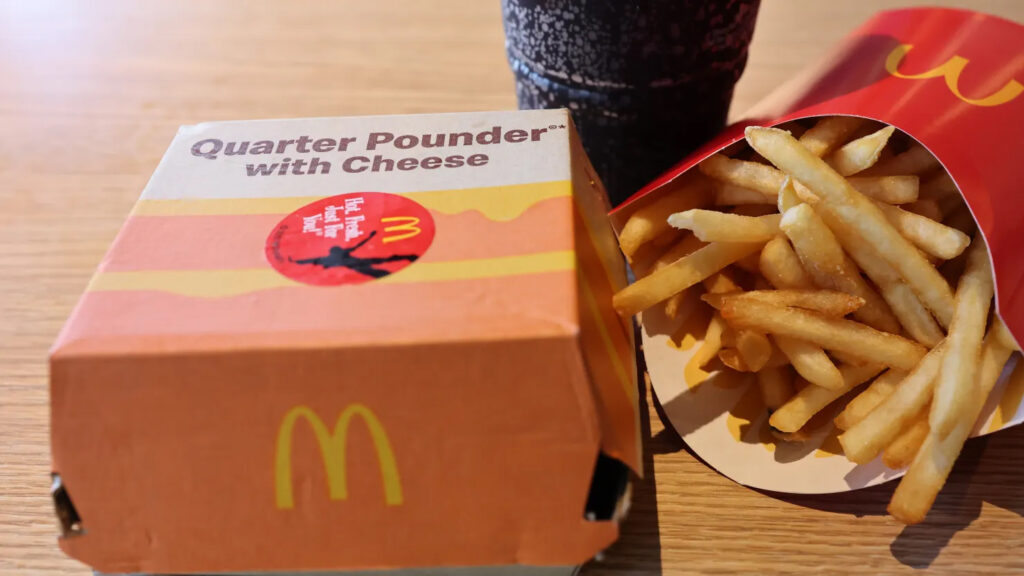BUSINESS
Steps McDonald’s should take following the E. coli outbreak
PUBLISHED FRI, OCT 25 2024 8:00 AM EDT

As McDonald’s and health authorities work swiftly to manage a deadly E. coli outbreak, the fast-food chain faces significant challenges in maintaining the trust of both customers and investors in the coming months.
Since the Centers for Disease Control and Prevention (CDC) issued an advisory on Tuesday linking the company’s Quarter Pounder burgers to an E. coli outbreak that has resulted in one death across 10 states, McDonald’s shares have dropped by 7%.
Health investigators suspect that the slivered onions used in the Quarter Pounders are the likely source of contamination. McDonald’s confirmed that it has removed onions supplied by California-based Taylor Farms from its supply chain. Taylor Farms has recalled four raw onion products due to potential E. coli contamination, as noted by restaurant supplier U.S. Foods in a notice to customers. (U.S. Foods does not supply McDonald’s.)
Initially, the CDC reported 49 illnesses related to the outbreak occurring between September 27 and October 11. That number has now increased to 75 cases across 13 states, with at least 22 hospitalizations, according to a CDC update on Friday. Health experts warn that the total number of cases may continue to rise as the investigation unfolds.
It is too early to gauge how this outbreak might impact McDonald’s business, particularly if the number of cases increases. However, investors are concerned about potential declines in sales for the company, which has been trying to recover from decreased customer traffic by providing deals to attract price-sensitive diners.
Company representatives stated on Wednesday that it is premature to determine if the outbreak is affecting restaurant sales. McDonald’s is scheduled to release its third-quarter results on October 29, before the market opens.
The extent of the damage to the business will largely depend on how effectively McDonald’s manages the outbreak and how successfully it can reassure customers about the safety of dining at its restaurants.
Potential Investigation Developments
Investigations into multistate foodborne outbreaks can range from a few weeks to several months.
Dr. Thomas Jaenisch, an epidemiology professor at the Colorado School of Public Health, believes that federal agencies and McDonald’s should determine the source of contamination and the sequence of events leading to the outbreak within two to three weeks. He noted that testing ingredients and supply sources “shouldn’t take that long.”
The CDC has indicated that the number of confirmed cases related to the McDonald’s E. coli outbreak may increase as the investigation progresses, as many individuals recover from infections without testing or receiving medical attention. Typically, it takes three to four weeks to ascertain whether a sick individual is part of an outbreak.
There is also a chance that new cases could emerge in states or regions that have not yet reported illnesses, according to Xiang Yang, a meat scientist at the University of California, Davis. For instance, a traveler to a state affected by the outbreak, like Colorado, could contract E. coli and return home with the infection. Additionally, it remains unclear whether the onion supplier distributes ingredients to restaurants in other parts of the U.S., which could potentially spread the E. coli strain associated with the McDonald’s outbreak.
The specific strain involved, O157:H7, can lead to severe complications, including kidney failure. One patient in the outbreak suffered from hemolytic uremic syndrome, a serious condition. The federal government effectively prohibits the sale of any ground beef contaminated with this strain, mandating that suppliers test their products accordingly.
E. coli can be transmitted through contaminated food or water, or via contact with an infected person, environment, or animal.
The CDC and the 10 affected states are interviewing each patient case to gather detailed information about their exposure to E. coli, including what they consumed and when, according to Craig Hedberg, co-director of the Minnesota Integrated Food Safety Center of Excellence. Although he serves on McDonald’s Food Safety Advisory Council, he has not worked with the company in relation to this outbreak.
The CDC and the states are collaborating with the Food and Drug Administration to trace the distribution of onions and identify the specific source of contamination. The gathered information is also shared with the U.S. Department of Agriculture’s Food Safety and Inspection Service, which addresses issues related to ground beef.
The CDC is investigating both the uncooked slivered onions and the beef patties in the Quarter Pounder as potential causes of the outbreak.
Advertise With Us
BVD Newsletters
Sign up for free newsletters and get more CNBC delivered to your inbox
Get this delivered to your inbox, and more info about our products and services.
© 2024 BVD LLC. All Rights Reserved.
Data is a real-time snapshot *Data is delayed at least 15 minutes. Global Business and Financial News, Stock Quotes, and Market Data and Analysis.
Market Data Terms of Use and Disclaimers
Data also provided by REFINITY
